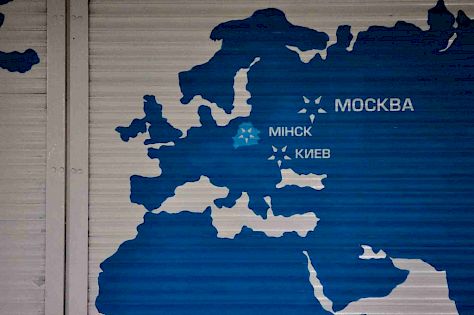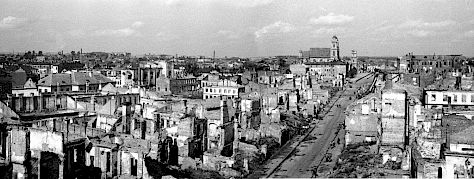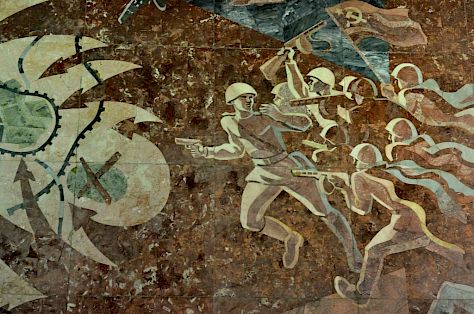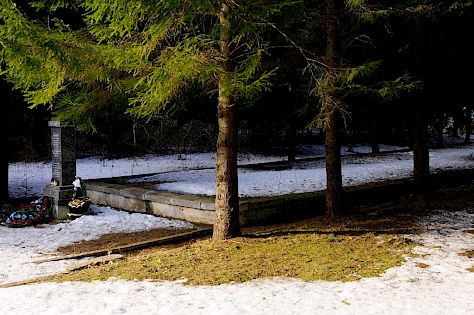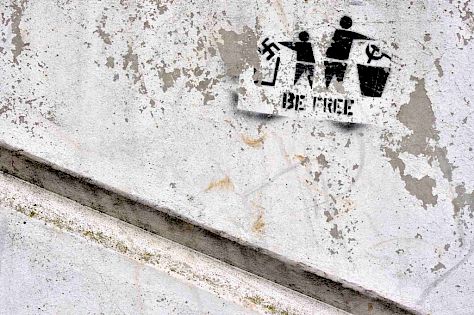Wartime Ghosts and Souls in Transit: Placing Soviet History in a Global Context with Franziska Exeler
Even at a time of a supposed turn towards more global history, our perspectives of Eastern Europe and the former Soviet Union remain dogged by an insistence on the inescapability of regional specificities. Not least among these are the names for these places themselves – Eastern Europe, itself a relatively recent moniker, cuts off places that once tallied among the richest in all of geographical Europe, like Prague, from a "real Europe" of Paris, London, and Rome, as if "Eastern Europe" itself has a specific, idiosyncratic but common character in a way not true of "Western Europe." Even if the process of EU expansion and economic integration has rendered formerly ridiculed "Polacks" into Europeans, the same courtesy is not always extended to Ukrainians or Belarusians. As recent Western discourse over the Russian annexation of Crimea and invasion of eastern Ukraine shows, commentators are eager to ethnicize and classify "Russian-speakers" from "Ukrainian-speakers," as if the place is explainable only through reference to ethnicity and identity.
Obviously, the experience of both the Cold War and, for countries further east, membership in the Union of Soviet Socialist Republics, matters greatly for the present and future of countries like Poland, Belarus, Ukraine, and, not least, Russia. But to acknowledge the importance of local specifics or the Soviet heritage is not to admit to its monolithic mattering for the direction of those societies. Kiev and Warsaw as much as Singapore and London can be interrogated with the same array of questions, and with the same comparativist's gaze, that seemingly "more global" sites might invite.

That's why we're delighted to welcome as our guest to the Global History Forum Franziska Exeler, a historian of the Soviet Union and Eastern Europe, whose research explores the impact that extreme violence has on state and societies. In her work, she analyzes the choices that inhabitants of the Soviet European borderlands made and were forced to make under Nazi wartime rule, and examines their political, social and personal repercussions. By locating the Soviet case within the larger, indeed global moment of legal, political, and personal reckonings with the Second World War, she also investigates how community rebuilding could occur within, and at times through, an illiberal regime.
Franziska, who completed her PhD in History at Princeton University in 2013, is currently a post-doctoral fellow at the Higher School of Economics in Moscow. We had the chance to sit down with her recently to discuss her work and her reflections on how historians of Eastern Europe and the Soviet Union might profitably situate their work in an international or global context.
•
We started by discussing Franziska's path to the historical profession. She grew up in Hamburg in what was then West Germany, "a tiny country in a tiny Europe", and was keen to get a sense of "another Europe" on the other side of the German-German border and eastward. The collapse of Communism, of course, made that possible, and when Franziska was still in high school, she travelled extensively throughout the former communist countries, getting a sense of both the once lost, but then-regrowing sense of a common Europe – but also of Poland, Hungary, East Germany etc. as stars in a massive galaxy of an antediluvian socialist world, too. By the time it came to choose what to study, Franziska came to Humboldt University Berlin in the reunified German capital, where the Chair in East European History had just been assumed by Jörg Baberowski. The research group, which included historians such as Susanne Schattenberg (now at the University of Bremen) and Malte Rolf (now at the University of Bamberg), teemed with energy, and Franziska was quickly hooked on the idea of pursuing her historical studies further. Language training took her several times to Russia and Poland, where she spent a semester studying at the University of Wrocław.
As it became increasingly clear that she wanted to embark on a Ph.D., the question soon arose where. While staying in Germany would have been an obvious choice, the United States seemed more tempting. She had already spent a year there at the age of sixteen, living with a host family and attending high school in Illinois. After her return from the US, her interests shifted towards Eastern Europe, yet as she was studying at the Humboldt University, her engagement with English-language scholarship on Russian and Soviet history made her aware of just how much work was pulsing out of American universities and institutes. She had the chance to travel to idyllic Palo Alto to attend a summer archival workshop at the Hoover Institution, where professors approached her about doing her graduate work in the United States. While completing a Master's thesis on women soldiers in the Red Army during the Second World War, she sent in the applications, and ultimately opted for Princeton University, one of the main centers for the study of Russian, East European and Eurasian history.
Soon, Franziska recalls, she was immersed in the "exhausting but rigorous and simultaneously exhilarating experience" of preparing for general exams and reading reams of scholarship – particularly in her fields of Russian and Soviet History, Modern European History, and Post-Colonial and Subaltern Studies. At Princeton, she had the chance to study with historians such as Stephen Kotkin (her dissertation advisor), Jan Gross, Ekaterina Pravilova, Anson Rabinbach and Gyan Prakash. Inspired by discussions on how to think of individual agency and subjectivity within illiberal regimes (and the ways in which historians can or cannot reconstruct the diversity of individual voices), Franziska returned to the post-Soviet space with a new eye, with new questions. Cities like Kiev, Kharkiv, and others in Ukraine all had their own fascinating histories, but it was off-the-beaten-track Belarus, perhaps still the most Soviet of all former Soviet republics, that grabbed her attention. The relative remoteness of the place was reflected in the lack of up-to-date travel guides, but once in Minsk, the country's capital, she found a byzantine labyrinth born urban and mnemonic. Minsk was almost totally destroyed during World War II, but was then rebuilt as a model Stalinist city in the post-war decades – except, Franziska learned, for certain mazes of shabby backstreets that constituted the semi-unreconstructed ruins of the Jewish Quarter.
For background, it's important to remember that while the Eastern Front of the Second World War is typically remembered as a Nazi-Soviet War (and thus often misremembered as a German-Russian war), the vast majority of the fighting, and, more importantly here, occupation, took place on lands that were parts of Soviet Belarus and Ukraine in the summer of 1941, when Hitler invaded. Hence, while perhaps less than 10% of Soviet Russia was occupied – itself of course leading to over a million dead in Leningrad alone – Belarus and Ukraine (as well as the Baltic republics) were completely occupied. The ensuing years of German rule turned the Soviet Union's western regions into infernos of death and devastation. Some worlds were completely eradicated, foremost the world of East European Jewry, while others underwent fundamental change. Of all Soviet republics, indeed of all European countries, Soviet Belarus suffered proportionally the highest human losses during the Second World War. One of the main sites of the Holocaust, the republic was also at the center of Soviet partisan warfare against the Germans. About 1.7 to 2 million people were killed or died as a result of the war, which translated into nineteen to twenty-two percent of the population that, by the summer of 1941, had lived in the regions that would constitute Soviet Belarus after the Second World War.
Walking around Minsk, Franziska began to wonder what life must have been like in the region after the summer of 1944, when the Red Army fully reconquered the republic from the Germans. Inspired by research on transitional justice and social reconstruction, a field that has been shaped by political scientists, anthropologists, and lawyers working on post-conflict states like Rwanda and former Yugoslavia, her dissertation project began to take form. How did the experience of war and occupation influence the ways in which individuals and social communities sought to reconstruct their collective lives after the war; how did they seek justice and retribution, i.e. punishment that they considered morally right; and how did the returning Soviet authorities confront the legacies of the war?
While examining these questions through the lens of Soviet Belarus, it is important to note that German rule over the Soviet western regions did not only lead to tremendous death and destruction. During the war, the situation in occupied territory was such that it was impossible for locals not to come in contact with the occupation regime. The Germans depended heavily on local personnel, as a result of which some people became entangled and complicit in German crimes. Once Soviet partisan warfare picked up in mid-1942 (first in the eastern part of Belarus, later also in the western part), civilians were increasingly under pressure not just from the German but also from the partisan side. In this situation, many of the choices that people had to make were what could be called 'choiceless choices' (adapting a term coined by Lawrence L. Langer). By that, Franziska explains, she means that when people were confronted with decisions, all options entailed a destructive effect on their personal lives, families, villages or social communities, such as, for example, when a village head had to decide whether to hand over fellow villagers as forced laborers to the Germans and fear reprisals from the partisans, or refuse to do so and fear German collective punishment.
Saying that many choices that people were forced to make under Nazi occupation were 'choiceless choices,' however, does not mean that everybody had the same choices to begin with. While all civilians found the space within which they could act circumscribed, first by the Germans alone, later by both Germans and Soviet partisans (and, in some regions, by anti-Soviet nationalist partisans), that space was much smaller, almost non-existent for Jews and much larger for non-Jews. In other words, locals were not just passively subjected to external pressures, and individual agency always existed. Within the constraints of occupation, non-Jews had a range of options at their disposal that they could decide to pursue or not. Some choices were far-reaching, such as when people volunteered to work in the German-overseen local police forces, or when individuals decided to give shelter to Red Army soldiers, Jews or partisans, and in doing so risked their lives. Yet wartime choices also included smaller, seemingly insignificant acts, such as taking furniture from a murdered Jewish neighbor's apartment, or refraining from doing so. As political circumstances changed over time, and thus the terms of involvement with both Germans and partisans, the consequences of individual decisions thus varied.
When the tide turned on the Eastern Front and the Red Army reconquered more and more territory from the Germans, one task held high priority for the Soviet authorities, party leaders and secret police officers alike: determining who had and who had allegedly not been loyal to the Soviet Union during the months and years of Moscow's absence. What did you do during the war – this question, however, also haunted non-state actors and social communities alike, hovering over private and public encounters between returning evacuees and colleagues, soldiers and family members, Holocaust survivors and their neighbors.
Franziska spent months pouring through archives in Belarus, Russia, Israel, Poland, Germany, Ukraine and the United States so as to reconstruct the history of the aftermath of Nazi occupation, to understand how both the Soviet authorities and private individuals approached, investigated, and evaluated the issue of someone else's wartime behavior – a process which she also calls 'reckoning with war and occupation' (but 'reckoning' less in the sense of settling accounts, and more in the sense of dealing, confronting). In doing so, people determined – but also disagreed – on what exactly had constituted right and wrong wartime choices. Franziska's dissertation, which she is currently turning into a book titled Wartime Ghosts: Nazi Occupation and Its Aftermath in the Postwar Soviet Union, traces the fate of local communities torn apart by occupation and makes visible the many absences and silences; shows how individuals sought justice, revenge or assistance from their neighbors and courts; and assesses the role of the Soviet authorities in the processes of retribution and reconstruction. These, it is crucial to understand, took place at a time of great flux and war-induced migration, as hundreds of thousands of soldiers and civilians were moving into, out of, within and through the republic, trying to get back home – or trying to avoid just that. These processes also took place at a time when Belarus was still divided in two different political parts: East Belarus, which had belonged to the Soviet Union for about two decades before the war, and West Belarus, which had only been annexed from Poland in 1939 and thus had by the end of the Second World War overall been longer under German than under Soviet rule.
Ultimately, Wartime Ghosts argues that reckoning with war and occupation was a highly personal and individualized process. Intrinsically heterogeneous, it was contingent on a multitude of factors, including the social relations that an individual had held before the war and his or her position vis-à-vis the Soviet state, and the ways in which the war had transformed these. Precisely because personal reckonings with occupation took on a variety of forms, however, the differences between an old Soviet region like East Belarus and a new Soviet region like West Belarus were much less pronounced in this process than one might think. To be sure, east/west differences certainly existed in other spheres; indeed, one of the benefits of studying the aftermath of World War II through the lens of Soviet Belarus is that it allows us to understand how the Soviet state was able to rebuild its capacity under very different political circumstances. The authorities' suspicion of the so-called zapadniki (the Westerners), inhabitants of the formerly Polish regions, ran deep, reflected in the fact that for many years after the war, hardly any of them could be found in mid and high-level positions within the Soviet party-state in Belarus. These positions were occupied by the vostochniki (the Easterners), individuals who had been born in the old parts of the Soviet Union. When it came to issues such as the political reliability of cadres, then, Soviet state policies and practices did reflect a clear east/west difference. This, however, was not the case with how inhabitants of West and East Belarus chose to deal with the aftermath of Nazi occupation – precisely because the reckoning process as such was fundamentally diverse. Put another way, depending on the issue that we examine, the scope of the differences between the formerly Polish part and the old Soviet part of the republic thus varied considerably.
If the ways in which individuals and social communities, whether Belarusian, Polish or Russian-speaking, Christians or Jews, inhabitants of East or West Belarus, were intrinsically heterogeneous, this cannot be said about the ways in which the Soviet authorities dealt with the legacy of Nazi occupation. Moscow's punishment of those Soviet citizens it deemed traitors (izmenniki) and German accomplices (posobniki) was swift, usually conducted in secret, and often violent. At the few public trials, the state was careful to portray an image of legality, but this did not compensate for the nonexistence of due process of law in the Soviet Union. Nevertheless, the Soviet politics of retribution were not unambiguous. As the Red Army was reconquering more and more territory, Moscow came to think of retribution as a process in which different interests and aims – reclaiming authority by way of punishment and portraying the Soviet state as liberator and guarantor of justice – had to be balanced against each other. In consequence, the punishment of those deemed traitors became less strict in the late war and immediate post-occupation period.
However, this did not mean that legal reckoning with the war as such became more just, nor that the Soviet authorities acknowledged the moral gray zones of occupation. It also did not mean that the regime lost its ideological vigor. Rather, two strands of thinking existed side by side: the belief that the war had uncovered mass enemies in hiding, and the belief that the war had been an all people's war, proof of the unity of the Soviet people. Ultimately irreconcilable, their parallel existence spoke to the deep ambivalence ingrained into the Soviets' politics of retribution. This was best reflected in the 'traitor-turned-partisan' phenomenon, but it also manifested itself in the discrepancy between the official representation of the Second World War as an all people's war, on the one hand, and the profound suspicion that the Soviet authorities held towards anyone who had stayed in occupied territory during the war, on the other hand. The kind of Soviet state that emerged after the war, then, was at once powerful and insecure, able to rebuild its capacity, yet nevertheless conflicted about the ways in which it chose to deal with the aftermath of Nazi occupation.
As Franziska's project was taking shape, the time spent poring over archives in Belarus, Russia, Poland, Israel, Germany, Ukraine and the United States offered novel insights on the kind of history she wished to write. One was an interest in a non-national framework. For scholars of the Soviet Union, it is self-evident that the different Soviet republics were not sovereign states – and that as nations, they were decidedly Soviet nations. By that is meant that whatever expressions of Belarusianness, Russianness or Kazakhness were promoted in the Soviet Union, these still shared certain cultural traits that were distinctly Soviet, while Russian simply served as the lingua franca of the Soviet empire. That legacy can to this day be felt throughout the post-Soviet space, where language use defies easy national categorizations. Just because the majority of people in nowadays Belarus speak Russian as their first language, for example, does not entail that they self-identify as Russians. In regions where multi-linguality is the norm and not the exception, easy patterns of what makes, and what does not make, a nation-state simply do not fit. A place like Belarus, then, which at first glance seems like an obscure backwater therefore lends itself quite nicely to bigger questions beyond the discipline of Russian or Soviet studies.
Secondly, notes Franziska, "doing Soviet history gives you an automatic comparative lens about centers and peripheries that's helpful." A nominally federal if in reality heavily centralized Union of fifteen Soviet Socialist Republics, the Soviet Union at once bordered Poland and Finland as it did Iran and Afghanistan. This means that studies in Soviet history can at once profitably be pitched as engaging in broader comparative issues of Eastern European or Eurasian history – or as a comparative study between the way the Soviet system transformed geographies and peoples as different as Orthodox Belarusians and Shi`a Muslim Badakhshanis in Tajikistan. But, continues Franziska, the big challenge for historians of the Soviet experience, in her mind, is how they can engage with even larger-scale comparative, transnational and global questions – something she has been trying to do by immersing herself in the historiography of modern East Asia. Recently, she explains, she has been reading through much of the work of John Dower, Timothy Brook, Rana Mitter, C. Sarah Soh, Yinan He, R. Keith Schoppa and others to understand how experts on China and Japan have studied the extreme violence of the Second World War in East Asia and the ways in which their postwar societies have grappled with it.
But why should a historian interested in the Second World War in the Soviet Union engage with the historiography of East Asia? Indeed, as Franziska explains, the wartime histories of Eastern Europe (including the Soviet Union and the Balkans) and East Asia are usually not studied together. Considering how much they had in common, though, this is rather surprising: Both Eastern Europe and East Asia experienced severe occupation regimes (above all German and Japanese, but also other Axis powers), extreme violence, and guerrilla/partisan warfare. It was in these regions that most of the victims of the war had lived. At the same time, there were of course also significant differences: the Nazi regime was genocidal, the Japanese state was not. The idea for her, then, is to start a conversation between the two historiographies, to examine what questions historians of East Asia have brought to their source material, and to see if that might lead to new angles and new questions that can be productive for historians of the Soviet Union.
Beyond that, however, she is also searching for transnational and global interconnections and interactions. As a postdoctoral fellow this year at the Higher School of Economics, she has in particular been working on expanding the dissertation into a book manuscript with more consciously international sensibilities. "In the immediate aftermath of the Second World War, there both existed many national, domestic moments of punishment, retribution and justice-seeking, but there also exited a truly global one, as evidenced by the International Military Tribunal at Nuremberg in 1945/46." How the Soviet case fit into this global moment of legal reckoning after the war, and how it interacted, overlapped and was potentially influenced by Moscow's domestic legal reckoning with the war – that is one of the main questions Franziska is currently exploring.
Skeptics might think that she is trying to compare apples to oranges – Soviet domestic trials with international war crimes tribunals, like those at Nuremberg – but both the actual historical record and her work is much more subtle than that. The end of the Second World War saw countless individuals in almost all of the former belligerent countries put on trial for their wartime activities. The most well-known of these trials, of course, took place at Nuremberg, although the de facto-international trial in the form of the Tokyo-based International Military Tribunal for the Far East, which tried Japanese political and military leaders, is also well-known. However, the far, far more numerous trials in the aftermath of World War II were "non-international tribunals" that were conducted under either the jurisdiction or the authority of just one state. Of these, some were 'war crimes trials', where one state prosecuted the national of a foreign state for having violating the laws and customs of war (or variations thereof, namely having violated international law or having committed war crimes). The overwhelming majority, however, were treason trials. Here, states in Europe and Asia prosecuted their own nationals for what they had done under foreign occupation, which usually meant either German or Japanese.
The Soviet case, as she explained at a recent session of the Global History Colloquium at Free University Berlin, is therefore of interest for at least two reasons. Firstly, given that Soviet military tribunals ran treason cases on their own population on the Eastern Front, to what extent did judicial norms developed for use in domestic cases "migrate" to international instances like the International Military Tribunal at Nuremberg? One aspect of Franziska's ongoing work explores this question, thus enriching a discussion on the USSR's engagement with international law that scholars like George Ginsburgs, Natalia Lebedeva and Francine Hirsch have opened in their work on Moscow's engagement with Nuremberg. Secondly, however, Exeler sees the possibility of anchoring the Soviet "domestic" story in a comparative lens alongside other national instances. What was precisely different about the Soviet Union's politics of retribution (and the ways in which Moscow experimented with domestic and international law) compared to that of another country (say, China) that had been occupied during the war?
Her work, Franziska explains, thus operates at three levels: Within the field of Soviet history, it contributes to research on the impact that the war, and more specifically the Nazi occupation of the Soviet western regions, had on the Soviet Union. As an analysis of the effects that war and foreign occupation have on social relations and solidarities, "Wartime Ghosts"also engages with scholarship outside the field of Soviet history. This includes the historiography on the Japanese occupation of much of East and Southeast Asia during the Second World War, as well as research on transitional justice and social reconstruction. One of the implicit assumptions of this research field, however, is that justice-seeking and community rebuilding can only occur within liberal, democratic societies. In contrast, Franziska's research seeks to show how individuals and local communities sought to reconstruct their lives within (and at times through) an illiberal regime such as the Soviet Union – therefore also helping us to explain the broader phenomenon of (non-)reconciliation under the conditions that a majority of mankind still lives under, namely authoritarianism. Finally, her work explores how the Soviet Union's international and domestic legal reckoning with the war overlapped, interacted and contributed to the emergence of the larger, indeed truly global moment of punishment, retribution and justice-seeking in the aftermath of World War II.
Enterprising throughout, however, Franziska has begun work on a second book-length project that will occupy her long after she wraps up the World War II-project. She recalls a conversation with one of her Belarusian oral history interview partners who told her, reflecting about the Soviet experience: "Once we were a big country; now we're a small country." The remarks weren't a case of anti-American or anti-European blustering, of post-Soviet nostalgia: as any of the millions of men who served in the Soviet Army, or former Communist Party members can tell you, mobility across a gigantic Eurasian space was one of the core experiences of life in the Soviet Union. No other modern state, it seems, deliberately shifted its people from one place to another to the degree that the Soviet Union did. And of course, the Soviet state did not just restrict itself to more prosaic forms of putting citizens in motion: Cases like the Gulag or special settlements show most brutally, the darkest side of state-induced movement in the Soviet Union," explains Franziska.
Her new project, then, proposes to explain the dynamics of space, movement and identity in twentieth-century Russia, Eastern Europe and Eurasia. For Soviet citizens, the linguistic, cultural, religious, ethnic and topographic diversity of their country revealed itself fully often only through the act of moving (or being moved). Drawing on personal and autobiographical material, Franziska will examine how encounters with this diversity affected people's understanding of self in relation to their fellow citizens and to the Soviet state, and their feelings of belonging (in other words, citizenship broadly understood). It will also investigate to what extent these encounters shaped the creation of a Soviet empire and cultural fabric, whose legacies are visible to this day throughout the post-Soviet space. Referring back to her earlier remarks, she hopes to blend fieldwork in two very different peripheries: the western borderlands (present-day Ukraine, Belarus, the Baltic republics, and western Russia) and the less-familiar-to-her Kazakhstan, where she will conduct an initial exploratory research trip this summer. Her journey from the woods of Eastern Europe to the steppes of Central Asia represents not just a turning point for this young historian, but also the route of deportation – and reinvention – for generations of Soviet subjects shuttled around the empire.
•
As Franziska prepares for departure to the land of tulips and fermented yak milk, we are impressed by the way in which her work shows how contexts like Belarus that seem thoroughly "national" or "Soviet" can actually evoke bigger questions if only viewed in the proper lens. We look forward to the appearance in print of her first project, and thank her for participating in this installment of the Global History Forum.
